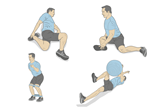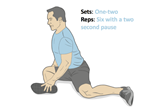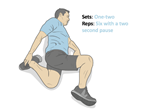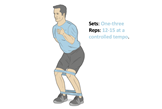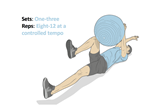How to exercise like a Pro
Published: Last updated:
Justin Buckthorp, Performance consultant to Justin Rose, Chris Wood and Charley Hull, talks you through four exercises to help your game
I’ve worked with European and PGA Tour pros since 2007 and in that time, there have been big improvements in the quality of care given to players. This has become even more important with the game becoming more competitive – and potentially depleting – than ever before.
Courses are longer and seasons are tougher, so exercise must be used very strategic. Sometimes, we structure a training programme to aid recovery and offset muscle imbalances from travel. On other occasions, exercise is designed to stress the system and build specific components of fitness, such as strength, power and speed. Exercise is medicine, so dosage is important.
If a player cannot access a position in the swing due to tissue tightness, they are going to either deviate from that position (and experience swing faults) or work too hard to get to that position (and experience injury through micro trauma of the muscles). We all know golf is hard enough without needing to compensate for poor mobility and stability. Below, I’ve illustrated four exercises which are tailored to gaining distance, improving dispersion and preventing injury.
FLOOR 90/90 HIP STRETCH

Sets: One-two
Reps: Six with a two second pause
Set up: Start with the lead leg bent at 90 degrees on the floor. The trail leg can be extended behind you or more flexed at the knee if needed. Use the arm to support your body weight.
Movement: Lean forward until you feel a stretch in the hips and glutes without rounding the lower back. Maintain a long spine throughout, like a waiter’s bow.
Tip: To increase the stretch into the hip and help with thoracic spine mobility, rotate the chest toward the lead hip. Chris Wood likes to keep the hand in the air and reach across, while others like Justin Rose place both hands on the floor and work around a stable base.
Great for: Improving your ability to load into the hips in the backswing and through impact.
SIDE LYING QUAD AND T-SPINE STRETCH

Sets: One-two
Reps: Six with a two second pause
Set up: Start in a side-lying position with the left hand supporting the right knee in the air, and the right hand holding the left foot.
Movement: Inhale to prepare, then exhale and open up the chest to the sky whilst pulling the heel to the glute with your hand. This will create a stretch on the front of the trail leg. You may feel a stretch through the chest as you open up the thoracic spine.
Tip: Breathe into and out of the stretch. Let your breath dictate when to pause and when to sink into a deeper stretch. Do not force the stretch; the reps will do the work for you over time.
Great for: Improving hip and thoracic mobility during the swing
MINI BAND WALKS

Sets: One-three
Reps: 12-15 at a controlled tempo
Set up: Place two mini bands at the ankles and knees, with a stronger band at the knees. Set up in a slight hip hinge position with the ankles, knees and hips flexed, and a slight forward lean from the hips. For feedback on posture, place one arm on the chest and the other on the lower back. The lower back should be in a neutral spine position (neither rounded, nor hyperextended).
Movement: Step sideways, keeping the ankles and knees at hip-width apart and the upper body still. This will keep the mini bands under tension and activate the glutes.
Tip: Imagine you are side-stepping under a low ceiling. This stops the head moving up and down as you perform the exercise. Try to feel like you are pushing into the ground, whilst keeping the upper body quiet. This helps to get the right muscles ring in the glutes.
Great for: Improving hip stability in the swing and preventing unnecessary sway and slide.
FLOOR BALL CRUSH
Sets: One-three
Reps: Eight-12 at a controlled tempo
Set up: Lie on your back with a stability ball between the hands and knees. The legs will be raised in a triple flexed position (ankles, knees and hips flexed).
Movement: Draw the belly button in towards the spine, and then try to “crush” the stability ball with your hand and knee as you slowly lengthen one arm and the opposite leg a few inches away from you.
Tip: Work within a small range of motion and then slowly increase the difficulty by extending your arm and leg as far as possible. Feeling that you “crush” the stability ball helps activate the abs and prevent excessive arching of the lower back.
Great for: Preventing excessive spinal extension in the backswing and finish.

